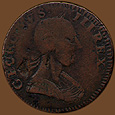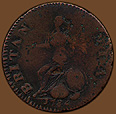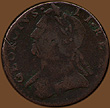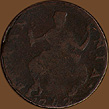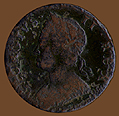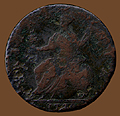Unattributed Imitation British Halfpence
I. Struck Imitation Halfpence
obverse |
|
reverse |
| |||
1784 Vlack 14-84A Unattributed Imitation Halfpenny
Obverse: GEORGIVS . III . REX
Reverse: BRITAN NIA . 1784
Weight: 104.8 g (6.79 grams) Diameter: 28.5 mm Reverse die alignment: 110° clockwise (3:40 o'clock)
Comments: This is a fairly rare coin which Peters assigns as a R6 on the rarity scale, meaning 10-20 examples survive, although August and Sarrafian have recently revised this to an R5 (in their scale, 17-32 examples) in lower grades and quite rare in grades of very fine of higher. The obverse can be identified by the unusual bust with what has been characterized as having a thin muscular neck and a long pointed nose. The legend is very close to the denticles around the rim. Also, in GEORGIVS the G and the I are further apart than the other letters; although that area is worn and only partly distinguishable on the present example. The right half of the legend is close together, with much more space than usual between the X and the edge of the bust. This example has two planchet voids, one on the neck and another after the ribbon ends.
The reverse die 84A can be distinguished by the thin figure of Britannia. The letters in the legend are unevenly spaced with the first I higher than the other letters. There is a double exergue line. In the date the numerals are hand cut (rather than stamped), the 1 has a hook like a J and the 17 touch the line. The end of Britannia's pole touches the corner of the 7. Also note there is a large oversized denticle at the left end of the exergue line. There is a large void at the top of Britannia's left leg and smaller ones on the right edge and around the upper body. This year (1784) is not found on any other halfpenny and these dies were not used with any other combinations. See the introduction to this section for additional comments.
Provenance: Donated to Notre Dame in 1887 as part of a 2,300 item coin collection (see: The Notre Dame Scholastic, vol. 21 (September 1887) 45.
obverse |
|
reverse |
| |||
1762 Anton 60 Unattributed Imitation Halfpenny
Obverse: GEORGIVS . II. REX .
Reverse: B[RI]TAN NIA . 1762
Weight: 85.2 g (5.52 grams) Diameter: 27.6 mm
Comments: This coin is thought to be of American manufacture by Anton and Kesse (Forgotten Coins p. 60), who attribute it to an anonymous minter using hand cut dies (as opposed to using punches). It is not listed by Vlack. Unlike the Machin's Mills imitations and the above Vlack 14-84A, this coin does not appear to have any rim design. The obverse displays a bust right George II. In GEORGIVS there is more space between the V and S than between the other letters. In the roman numeral II the first I leans to the left. The second I and the R are close to the stop while the E and X are widely spaced. The upper ribbon on the bust points to the final stop.
The reverse has a wide Britannia. Her hand points to the first vertical stroke of the A. Below the single exergue line the date is rather unusual. The first 1 is very short and has a long serif so that Anton calls it a 7, thus he says this is a 7762 error. The small 1 and 7 are close, both have been cut so that the bottom portion of those numbers is off the planchet; while the 6 and 2 are fully present and are spread further apart. The bottom end of Britannia's pole is faintly visible on this example, it points just to the right of the 7.
Provenance: Donated to Notre Dame in 1887 as part of a 2,300 item coin collection (see: The Notre Dame Scholastic, vol. 21 (September 1887) 45.
II. Cast Imitation Halfpence
obverse |
|
reverse |
| |||
1749 G2HD cast counterfeit Unattributed Imitation Halfpenny
Obverse: GEORGIVS . II . REX
Reverse: BRITAN NIA . 1749
Weight: 139.5 g (9.04 grams) Diameter: 28.55 mm
Comments: Cast halfpence from 1749 are usually considered to have been manufactured in America since a large portion of the regal 1749 halfpence were sent to America, as mentioned in the introduction to this section. This coin shows many of the charistericts of sand cast copies such as being out of round and having indistinct lettering. The numerous depressions are probably from gas bubbles that could not escape during the cooling process. The nick in the rim at 2:00 o'clock probably represents the location of a the casting port. As the coin has a rather unusual ring to it I suspect it contains lead but no tests have been done on the metalic composition or specific gravity of this piece. The fabric of the reverse is similar to the obverse with indistinct letters and numerous small depressions. The bottom of the exergue is depressed inward near the rim. As this is opposite what would be 1:00 o'clock on the obverse, it was probably due to filing excess material from the casting port. In the date area the 174 are visible but only the circular top half of the 9 can be distinguished. It is clearly a 1749 rather than a 1740 halfpenny for George II halfpence from 1740-1745 used the second obverse which contains a U in GEORGIUS, while the remaining years (1746-1754) used the third obverse with the V as GEORGIVS. This coin has the third (V) obverse. See the Regal British halfpence section for an example of a regal issue 1749 halfpenny. For a 900 dpi detail of the date area on this cast coin click here.
Provenance: Donated to Notre Dame in 1887 as part of a 2,300 item coin collection (see: The Notre Dame Scholastic, vol. 21 (September 1887) 45.
| Machin's Mills Imitation British Halfpence | Section Contents | Blacksmith Coppers |
|
For viewing tips and information on optimal computer settings click
here.
For questions or comments contact Special Collections by: |
